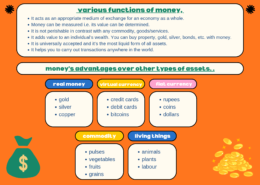Talk about how climate change could affect agriculture in India. In this regard, what actions has the government taken? (Answer in 200 words)
Pradhan Mantri Jan Dhan Yojana (PMJDY) is a National Mission on Financial Inclusion encompassing an integrated approach to bring about comprehensive financial inclusion of all the households in the country. The plan envisages universal access to banking facilities with at least one basic banking accRead more
Pradhan Mantri Jan Dhan Yojana (PMJDY) is a National Mission on Financial Inclusion encompassing an integrated approach to bring about comprehensive financial inclusion of all the households in the country. The plan envisages universal access to banking facilities with at least one basic banking account for every household, financial literacy, access to credit, insurance and pension facility.
Role of Pradhan Mantri Jan-Dhan Yojana in ensuring financial inclusion in India:
- Opening Bank accounts: PMJDY has brought the unbanked into the banking system, expanded the financial architecture of India and brought financial inclusion to almost every adult. As per government data, 55% Jan-Dhan account holders are women and 67% Jan Dhan accounts are in rural and semi-urban areas
- Access to Government schemes: PMJDY has been the foundation stone for people-centric economic initiatives. It has ensured a bank account for every adult which is required to get benefits of schemes like COVID-19 financial assistance, PM-KISAN, increased wages under MGNREGA, life and health insurance cover. Under PM Garib Kalyan Yojana, a total of Rs. 30,945 crore have been credited in accounts of women PMJDY account holders during Covid lockdown.
- Formal Financial System: Pradhan Mantri Jan-Dhan Yojana provides an avenue to the poor for bringing their savings into the formal financial system, an avenue to remit money to their families in villages besides taking them out of the clutches of the usurious money lenders.
- Prevent Systemic leakages: In today’s COVID-19 times, there is witnessed a remarkable swiftness and seamlessness with which Direct Benefit Transfer (DBTs) have empowered and provided financial security to the vulnerable sections of society. An important aspect is that DBTs via PM Jan Dhan accounts have ensured every rupee reaches its intended beneficiary and prevent systemic leakage. About 5.1 crore PMJDY account holders receive direct benefit transfer (DBT) from the Government under various schemes and because of PMJDY, the percentage of total DBT failures has decreased from 13.5% (FY 19-20) to 5.7% (FY 20-21).
Going forward, there is a need to move from financial inclusion to financial empowerment by providing credit. The PMJDY should become PM Jan Dhan Vridhi Yojana with universal access to bank credit to the most underprivileged sections of the society. Also, infrastructure needs to be cost effective and there is a need to build up a database to capture the income transaction history of the Jan Dhan account holders on the basis of which credit delivery models can be worked out.
See less

The world is currently experiencing significant climate change, leading to increased temperatures, rising sea levels, changes in cultivation patterns, and crop production, among other effects. According to data from 2022-23, around 18-19% of India's GDP is contributed by agriculture and related actiRead more
The world is currently experiencing significant climate change, leading to increased temperatures, rising sea levels, changes in cultivation patterns, and crop production, among other effects. According to data from 2022-23, around 18-19% of India’s GDP is contributed by agriculture and related activities. Consequently, climate change can have a noticeable impact on Indian agriculture.
See less• Challenging for specific crops: Crops like beet, broccoli, wheat , Cauliflower and other kharif crops tend to grow better in colder weather. An increase in temperature raises a challenge in their cultivation.
• Water Scarcity: The rising temperature levels also deplete the freshwater supply. India has approximately 4% of the world’s total freshwater reserve, 80% of which is utilized for agriculture. In India, agriculture without adequate irrigation is nearly impossible.
• Decrease in food supply: In case of challenging cultivation environment crop failure becomes common which poses a further negative impact on the availability of food crops in the long run. In India most food crops experience crop failure at a rate of 30-25 per cent.
Given the current situation, the Government of India has implemented sufficient research programs, actions, and schemes in response.
• National Mission for Sustainable Agriculture: As the name suggests the organisation not only focuses on sustainable Agricultural practices but also studies soil health, Climatic science, monitoring, modelling and networking.
• National Action Plan on Climate Change: Set up in 2008 by the Prime Minister’s Council on Climate Change; the primary aim of the organisation is to protect restore and enhance India’s diminishing forest cover so as to bring climate change under control.
The government also carries out numerous other activities to mitigate climate change. Agriculture is a significant part of the Indian economy, and its vulnerability to climate change is a cause of concern that requires immediate attention.